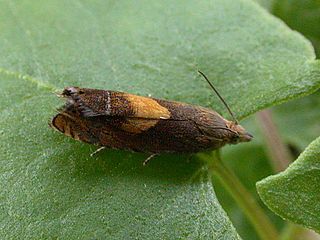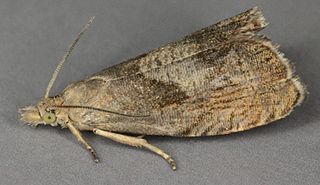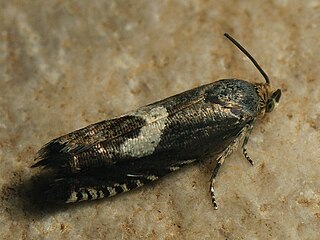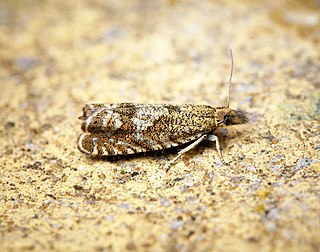
Dichrorampha acuminatana is a moth of the family Tortricidae. It is found in Europe and the Near East.

Dichrorampha petiverella is a moth of the family Tortricidae. It is found in the Palearctic realm.

Dichrorampha simpliciana is a moth of the family Tortricidae. It is found in Europe and the Near East.

Caradrina clavipalpis, the pale mottled willow, is a moth of the family Noctuidae. The species was first described by Giovanni Antonio Scopoli in his 1763 Entomologia Carniolica. It is found in the Palearctic realm. It is an introduced species in North America, where it was first reported from Queens in New York City in 1993. In 2009 it was found in Rochester, New York, so it appears to be established and spreading.

Pyrausta despicata, the straw-barred pearl, is a species of moth of the family Crambidae. It was described by Giovanni Antonio Scopoli in his 1763 Entomologia Carniolica.

Evergestis extimalis is a species of moth of the family Crambidae. It is found in the Palearctic.

Eulia ministrana is a moth of the family Tortricidae. It is found in the Palearctic and Nearctic realms.

Dichrorampha alpinana, the broad-blotch drill, is a species of moth of the family Tortricidae. It is found in almost all of Europe.

Ichneutica scutata is a moth of the family Noctuidae. It is endemic to New Zealand. This species can be found in the southern parts of the North Island as well as the eastern parts of the South Island. It is similar in appearance to I. insignis and I. skelloni but can be distinguished as I. scutata is much paler in appearance. It is likely this species inhabits lowland tussock grasslands as well as coastal dunes although it is not common in inland tussock grasslands. The larvae feed on a variety of herbaceous plants such as Plantago and Convolvulus species, Plagianthus divaricatus. It pupates on soil near its host plants. The adults are on the wing from late March to July.

Eana osseana, common name dotted shade, is a moth of the family Tortricidae.
Cryptolechia diplosticha is a moth in the family Depressariidae. It was described by Edward Meyrick in 1926. It is found in Colombia.
Dichomeris thermophaea is a moth in the family Gelechiidae. It was described by Edward Meyrick in 1923. It is found in Brazil and Peru.
Dichomeris immerita is a moth in the family Gelechiidae. It was described by Edward Meyrick in 1913. It is found in Sri Lanka.
Dichomeris cyclospila is a moth in the family Gelechiidae. It was described by Edward Meyrick in 1918. It is found in French Guiana.
Dichomeris lissota is a moth in the family Gelechiidae. It was described by Edward Meyrick in 1913. It is found in Assam, India.
Hypatima dissidens is a species of moth in the family Gelechiidae. It was described by Edward Meyrick in 1913. It is found in Mpumalanga, South Africa.
Moca mitrodeta is a moth in the family Immidae. It was described by Edward Meyrick in 1922. It is found in Peru.

Epinotia subocellana is a species of moth of the family Tortricidae. It is found in Asia and Europe and was first described by Edward Donovan in 1806.

Grapholita orobana is a moth belonging to the family Tortricidae. The species was first described by Georg Friedrich Treitschke in 1830. It is native to the Palearctic.

Dichrorampha plumbagana is a moth belonging to the family Tortricidae first described by Georg Friedrich Treitschke in 1830.













